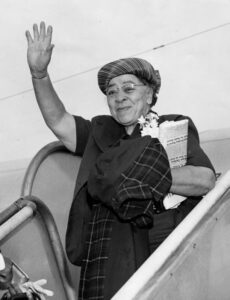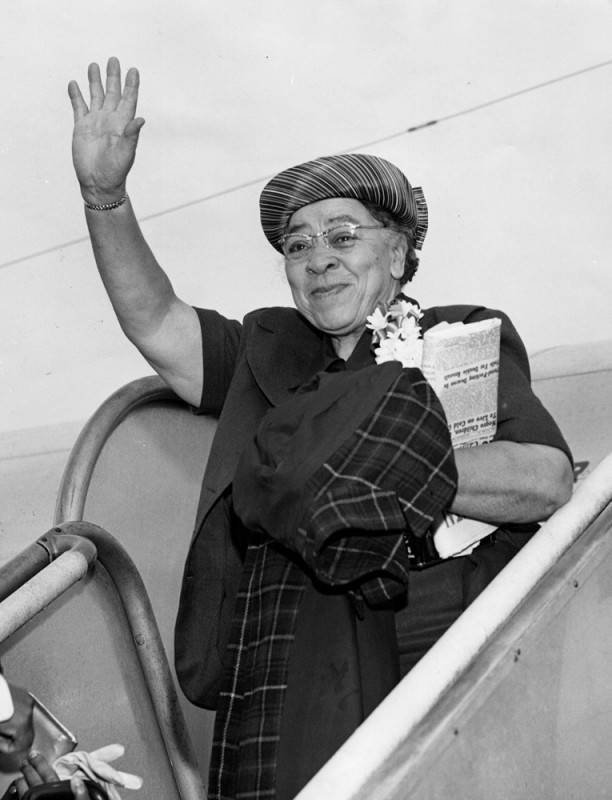Charlotta Bass and Bayard Rustin: Allies in the Fight for Justice
Charlotta Bass and Bayard Rustin shared a deep commitment to racial justice, economic equality, and the broader human rights goals.
Charlotta Bass and Bayard Rustin are two iconic figures whose lives were dedicated to fighting for civil rights, equality, and justice. Their individual contributions are widely recognized in American history, but their connection is often overlooked. Both were deeply committed to advancing Black freedom and worked within an interconnected network of social movements. This article will explore their shared ideological beliefs, their involvement in political activism, and the ways they supported each other’s work for justice.
Charlotta Bass: A Pioneering Journalist and Activist
Charlotta Bass was a trailblazing African American journalist, publisher, and civil rights activist. Born in South Carolina in 1874, she became one of the first Black women to own and operate a newspaper, the California Eagle. Under her leadership, the Eagle became a powerful voice for social justice, often exposing the deep racism and discrimination faced by Black Americans, particularly in Los Angeles and throughout the West Coast. When describing her editorial approach, Bass stated,
“When a person, an organization, even a newspaper gets the courage and fortitude that it is going to require to put this old world in such condition that it will be a fit and happy abode for all the people,….they must first be prepared to have their heads cracked, their hopes frustrated, and their financial strength weakened.”
Bass was also politically active, campaigning for civil rights, voting rights, and labor reforms. She became a key figure in the progressive movement. In 1952, she made history as the first Black woman to run for national office as the vice-presidential candidate for the Progressive Party. Her platform centered on ending racial segregation, promoting economic equality, and ensuring civil liberties for all Americans.
Bayard Rustin: The Strategist Behind the Scenes
Bayard Rustin was one of the most influential civil rights activists of the 20th century. Born in 1912 in Pennsylvania, Rustin was a key organizer of the 1963 March on Washington and a close advisor to Dr. Martin Luther King Jr. Rustin’s commitment to non-violence was central to his philosophy, which was influenced by his Quaker upbringing and study of Gandhian principles. As an openly gay Black man, Rustin faced significant challenges, often working behind the scenes to avoid becoming a target of criticism for the movement.
Rustin was deeply involved in efforts to combat racial segregation, discrimination, and economic inequality. In his “Negro Revolution in 1965” he stated,
“So, therefore, the crisis for the Negro movement today, is first to recognize that it is playing the role of catalyst, that it needs the support of millions of white people, and that we must now drop any slogans which tend to indicate that the Negro is interested in himself first.”
His work spanned several decades, from his early involvement in labor organizing to his later work in international peace movements. Despite his invaluable contributions to the civil rights movement, Rustin was often marginalized due to his sexual orientation, his affiliation with socialist groups, and his refusal to conform to mainstream expectations.
Shared Beliefs and Ideological Foundations
Charlotta Bass and Bayard Rustin shared a deep commitment to racial justice, economic equality, and the broader human rights goals. Both were driven by a belief that Black Americans could not achieve freedom without also addressing the intersections of class, gender, and global struggles for justice.
Bass’s newspaper, the California Eagle, consistently aligned itself with labor struggles, particularly the plight of Black workers in segregated industries. In Rustin’s view, the labor movement was critical to advancing civil rights for Black Americans, and he often worked to bridge the gap between labor organizations and civil rights groups. Both understood that racial and economic justice were deeply intertwined, and they dedicated their lives to this cause.
Their work also overlapped in their shared commitment to non-violence and political coalition-building. Bass was an early advocate of peaceful protests and political participation as a means to achieve civil rights. Rustin, known as the architect of the civil rights movement’s nonviolent strategies, similarly believed in the power of peaceful resistance to effect systemic change. Both also saw the importance of building broad, multiracial coalitions that included working-class people, women, and marginalized groups.
Mutual Influence and Collaboration
While Charlotta Bass and Bayard Rustin did not have a formal partnership, their activism operated within the same broader progressive circles. Both were part of the growing network of Black intellectuals, activists, and organizers who sought to dismantle Jim Crow laws and promote social justice.
In the early 1940s, Rustin was active with the Congress of Racial Equality (CORE) and the Fellowship of Reconciliation(FOR), both of which advocated for nonviolent civil disobedience. During this period, Bass was a vocal supporter of civil rights protests and lent her platform at the California Eagle to amplify the work of these groups. In her 1952 candidacy acceptance speech:
“For 40 years I have been a working editor and publisher of the oldest Negro newspaper in the least. During those 40 years I stood on a watch tower, watching the tide of racial hatred and bigotry rising against my people and against all people who believe the Constitution is something more than a piece of yellowed paper to be shut off in a glass case in the archives, but living document, a working instrument for freedom.”
Rustin’s efforts to organize sit-ins, Freedom Rides, and other forms of direct action were often covered by Bass’s newspaper, and she consistently used her journalistic influence to support his causes. Rustin discussed why he maintained nonviolent civil disobedience tactics in this interview (1979):
“And many of them wanted to do away with the non-violence of the struggle. My only view there is that we could not have made the progress we made if we had done what they wanted us to do. They wanted us to talk about violence, so they could destroy us. So long as we were adhering to non-violence, they could not destroy us.”
Moreover, both were staunch advocates of international human rights. Rustin’s activism extended beyond the borders of the United States, as he worked on behalf of African decolonization and supported Indian independence. Rustin describedhis international role in a personal letter,
“I know that we have a part to play both in this country and Africa. [. . .] There is to my mind nothing that will help raise the cause of non-violence in this country so much as our helping to raise in Africa further examples of the power of non-violence against groups that are more formidable than the British were in India. (Rustin 144)”
Bass, too, had a global perspective. Her newspaper frequently covered anti-colonial movements in Africa and the struggles of people of color around the world.
Political Challenges and Marginalization
One of the key similarities between Charlotta Bass and Bayard Rustin was the way in which both were marginalized for aspects of their identities and politics. Bass’s radical views and association with leftist causes often made her a target of surveillance and government scrutiny. The California Eagle faced harassmentand legal challenges as a result of her outspoken advocacy for Black rights and her denunciation of U.S. imperialism. She expressed her life-long commitment to global advocacy in her 1952 candidacy speech,
“To retire meant to leave this world to these people who carried oppression to Africa, to Asia, who made profits from oppression in my own land. To retire meant to leave the field to evil. For there is an evil that stalks in our land, evil that strikes at my people, that would enslave all people, that would send up the world in flames, rob us of our earnings to waste on arms, destroy out living standards, corrupt our youth, silence and enslave us with Smith Acts, McCarran Acts, passed by concentration camp Congressmen.”
Similarly, Rustin’s identity as an openly gay man in a homophobic society led to his marginalization within the civil rights movement. His past affiliations with socialist organizations and his arrest for homosexual conduct were used by detractors to undermine his credibility. Despite these challenges, both Bass and Rustin persevered, remaining committed to their work and refusing to compromise on their principles.
In the late 1940s, Bass and Rustin became involved in Henry Wallace’s Progressive Party campaign for the presidency. Wallace’s platform was based on civil rights, labor rights, and an end to racial segregation, all of which aligned with the ideals both activists held dear. Bass ran as the vice-presidential candidate for the Progressive Party in 1952, while Rustin continued to advocate for racial and economic justice through his work with unions and civil rights organizations. In 1979, Rustin described his role in the Civil Rights Movement as:
“I was always comfortable with being of service to whoever were the leaders. I do not consider myself a leader. I consider myself a spokesman for a given point of view. And I believe that it’s very important to work, which I am doing,”
Legacy of Courage and Commitment
Charlotta Bass and Bayard Rustin were figures whose courage and commitment to justice have left a lasting legacy. Their contributions to the civil rights movement, labor rights, and human rights have shaped the trajectory of Black activism in America. Bass’s leadership as a pioneering Black woman in journalism paved the way for future generations of Black women in media, while Rustin’s strategic brilliance helped solidify non-violence as a central tenet of the civil rights movement.
Though they operated in different spheres—Bass in the world of journalism and Rustin as a political strategist—both were united by their commitment to justice and their belief in the power of collective action. Today, their legacies continue to inspire activists and scholars who seek to understand the intersectionality of race, gender, sexuality, and class in the ongoing struggle for freedom and equality.


